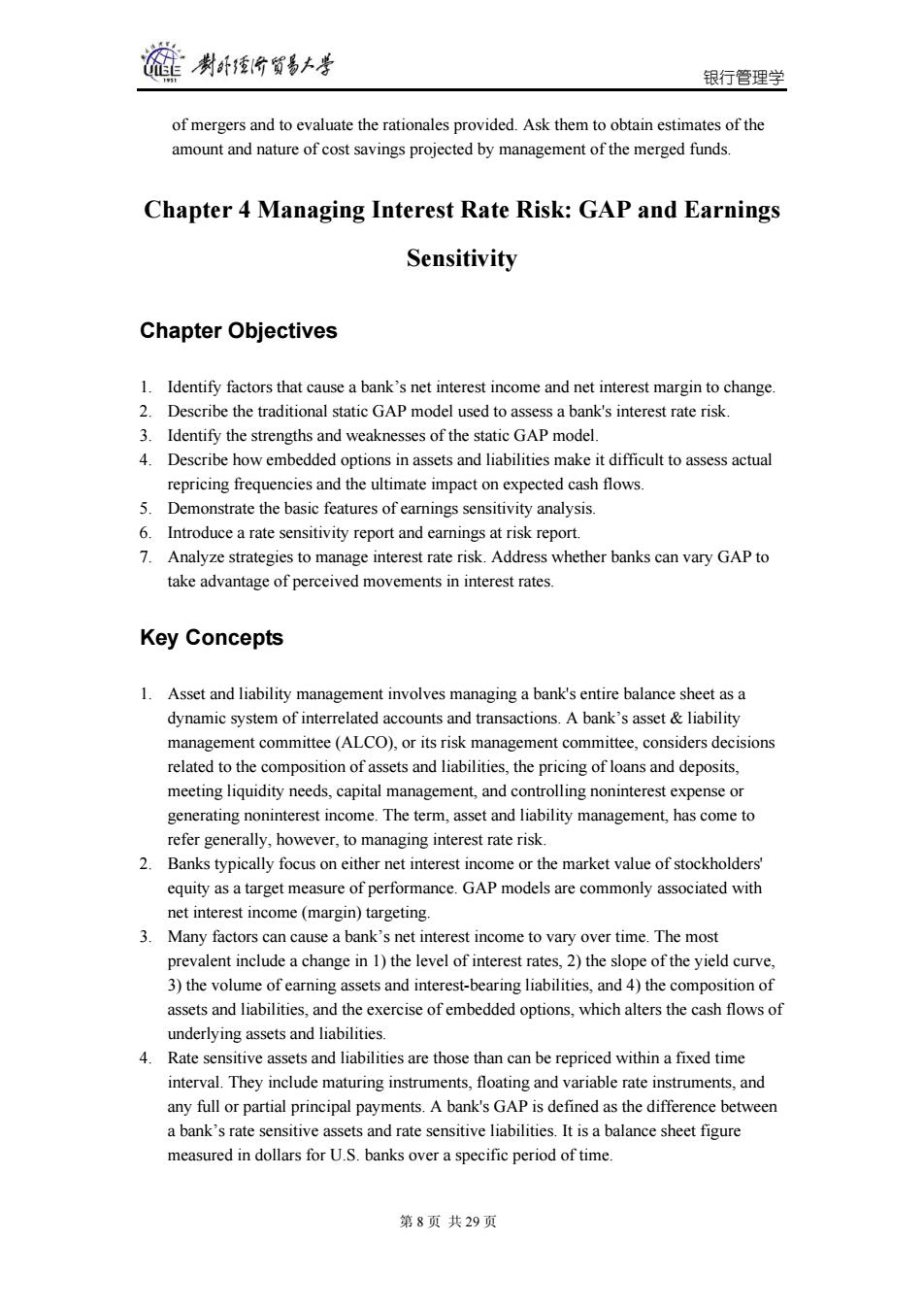正在加载图片...

制卧价贸易上孝 银行管理学 of mergers and to evaluate the rationales provided.Ask them to obtain estimates of the amount and nature of cost savings projected by management of the merged funds. Chapter 4 Managing Interest Rate Risk:GAP and Earnings Sensitivity Chapter Objectives 1.Identify factors that cause a bank's net interest income and net interest margin to change. 2.Describe the traditional static GAP model used to assess a bank's interest rate risk. 3.Identify the strengths and weaknesses of the static GAP model. 4.Describe how embedded options in assets and liabilities make it difficult to assess actual repricing frequencies and the ultimate impact on expected cash flows. 5.Demonstrate the basic features of earnings sensitivity analysis. 6.Introduce a rate sensitivity report and earnings at risk report. 7.Analyze strategies to manage interest rate risk.Address whether banks can vary GAP to take advantage of perceived movements in interest rates. Key Concepts 1.Asset and liability management involves managing a bank's entire balance sheet as a dynamic system of interrelated accounts and transactions.A bank's asset liability management committee(ALCO),or its risk management committee,considers decisions related to the composition of assets and liabilities,the pricing of loans and deposits, meeting liquidity needs,capital management,and controlling noninterest expense or generating noninterest income.The term,asset and liability management,has come to refer generally,however,to managing interest rate risk. 2.Banks typically focus on either net interest income or the market value of stockholders' equity as a target measure of performance.GAP models are commonly associated with net interest income (margin)targeting. 3.Many factors can cause a bank's net interest income to vary over time.The most prevalent include a change in 1)the level of interest rates,2)the slope of the yield curve, 3)the volume of earning assets and interest-bearing liabilities,and 4)the composition of assets and liabilities,and the exercise of embedded options,which alters the cash flows of underlying assets and liabilities. 4.Rate sensitive assets and liabilities are those than can be repriced within a fixed time interval.They include maturing instruments,floating and variable rate instruments,and any full or partial principal payments.A bank's GAP is defined as the difference between a bank's rate sensitive assets and rate sensitive liabilities.It is a balance sheet figure measured in dollars for U.S.banks over a specific period of time. 第8页共29页银行管理学 第 8 页 共 29 页 of mergers and to evaluate the rationales provided. Ask them to obtain estimates of the amount and nature of cost savings projected by management of the merged funds. Chapter 4 Managing Interest Rate Risk: GAP and Earnings Sensitivity Chapter Objectives 1. Identify factors that cause a bank’s net interest income and net interest margin to change. 2. Describe the traditional static GAP model used to assess a bank's interest rate risk. 3. Identify the strengths and weaknesses of the static GAP model. 4. Describe how embedded options in assets and liabilities make it difficult to assess actual repricing frequencies and the ultimate impact on expected cash flows. 5. Demonstrate the basic features of earnings sensitivity analysis. 6. Introduce a rate sensitivity report and earnings at risk report. 7. Analyze strategies to manage interest rate risk. Address whether banks can vary GAP to take advantage of perceived movements in interest rates. Key Concepts 1. Asset and liability management involves managing a bank's entire balance sheet as a dynamic system of interrelated accounts and transactions. A bank’s asset & liability management committee (ALCO), or its risk management committee, considers decisions related to the composition of assets and liabilities, the pricing of loans and deposits, meeting liquidity needs, capital management, and controlling noninterest expense or generating noninterest income. The term, asset and liability management, has come to refer generally, however, to managing interest rate risk. 2. Banks typically focus on either net interest income or the market value of stockholders' equity as a target measure of performance. GAP models are commonly associated with net interest income (margin) targeting. 3. Many factors can cause a bank’s net interest income to vary over time. The most prevalent include a change in 1) the level of interest rates, 2) the slope of the yield curve, 3) the volume of earning assets and interest-bearing liabilities, and 4) the composition of assets and liabilities, and the exercise of embedded options, which alters the cash flows of underlying assets and liabilities. 4. Rate sensitive assets and liabilities are those than can be repriced within a fixed time interval. They include maturing instruments, floating and variable rate instruments, and any full or partial principal payments. A bank's GAP is defined as the difference between a bank’s rate sensitive assets and rate sensitive liabilities. It is a balance sheet figure measured in dollars for U.S. banks over a specific period of time